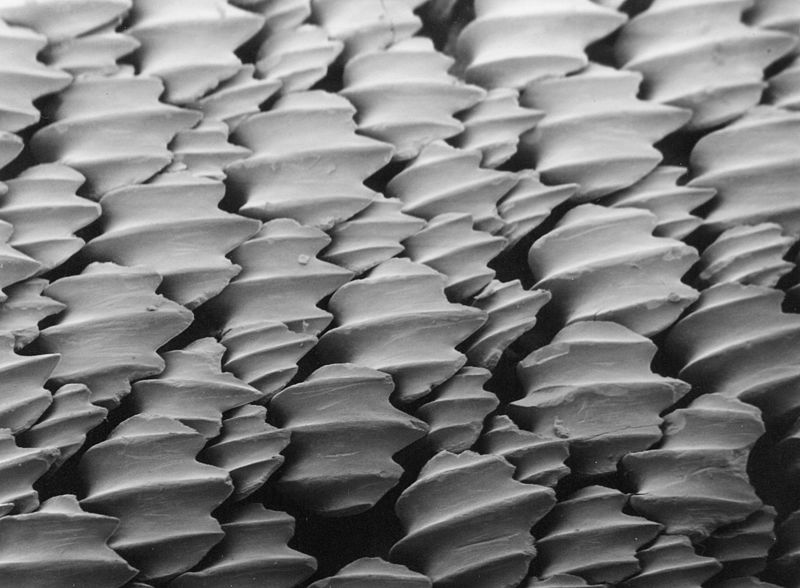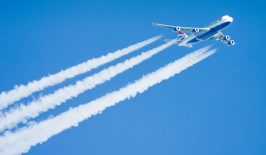When it comes to solving some of the modern world’s most pressing technological challenges, mother nature has often beaten us to a solution by a few million years.
Take for example, the issue of carbon emissions from aviation. If planes of all sizes can be made more aerodynamic, they will use less fuel and as a result, produce less carbon emissions. To help tackle this problem researchers from Lufthansa and BASF turned to one of the ocean’s sleekest hunters for inspiration: sharks.
Sharks have evolved over millennia to possess specially developed scales that can manage the water flow close to the skin, reducing water resistance. This allows them to increase their speed and reduce the amount of energy needed to swim and hunt. A team of aeronautic engineers from Germany, Switzerland and the US took some lessons from nature and created AeroSHARK, a durable bionic film that mimics the skin of sharks and optimises the airflow running across the outer fuselage of aircraft.
Each section of Aeroshark film consists of small prism shaped elevations – around 50 micrometres high – known as riblets. These flexible and lightweight sheets can be attached to almost any part of a plane and act to more efficiently channel air past the aircraft, reducing drag. If positioned on the wings, the AeroSHARK foils can also provide additional lift – allowing the aircraft to more efficiently remain in the air.
An added benefit of the AeroSHARK foil is its simple and low maintenance nature. The team expects the AeroSHARK layer to remain fully effective for around four years, and would also require almost no maintenance during this period. The film has additionally been tested to ensure it can withstand the vast differences in temperature, air pressure and weather conditions planes experience at different points in their journeys. Additionally, the film can also be easily and cheaply retrofitted to any preexisting aircraft with only minimal ground time needed.
In fact, some big players have already taken up the technology. Lufthansa will introduce the technology to its entire cargo fleet in early 2022. The ten Boeing 777Fs will have their fuselage and bellies covered in AeroSHARK, saving around 3,700 tons of kerosene and around 11,700 tons of carbon a year. This translates to around 48 individual flights from Frankfurt to Shanghai.
Swiss International Air Lines (SWISS) – a member of the Lufthansa Group – is going even further and will be the first passenger airline to use the technology. It plans to modify its “long” Boeing 777-300ER with around 950 square metres of riblet film, saving 4,800 tons of kerosene and 15,200 tons of carbon – the equivalent of 87 flights from Zurich to Mumbai.
Taken without context, these statistics sound quite impressive, although in overall terms of fuel savings, the AeroSHARK’s contribution may seem a bit anticlimactic. In reality, the above fuel savings are only in the region of 0.8 to 1.1 percent of previous levels. For example, for the month of December 2019 alone, the entire Lufthansa group (consisting of Lufthansa, SWISS, Austrian Airlines and Eurowings) conducted around 83,000 flights of all sizes. In the summer months, it may be as high as 100,000 a month. A drop in an ocean springs to mind.
However, it is still a reduction, and increasing efficiency by even one percent is a huge achievement in terms of engineering, especially with aircraft which are already highly aerodynamic. An added benefit is the ease and cost of AeroSHARK which should make it more attractive to airlines. Afterall, that reduction in carbon emissions also translates into a reduction in fuel costs – a major expense for airlines. A one percent reduction on a balance sheet is not a figure to be completely dismissed.
Overall, the air travel industry is going through somewhat of a tumultuous period. The COVID pandemic tested their ability to operate during global travel bans, while business travel – another big money maker – is expected to drop with the rise and acceptance of video conferencing. Regular consumers are also increasingly questioning the ethics of air travel, especially for shorter distances. In some counties, such as Sweden, this has resulted in the flygskam – or flight shaming – movement, a celebrity-led effort to curb unnecessary air travel.
Elsewhere, technology is hoping to provide environmental relief. For example, new low-emission fuels are being developed, while the next generation of electric aircraft could theoretically be taking off in the near future.









